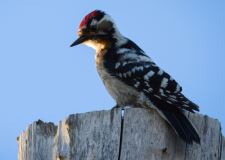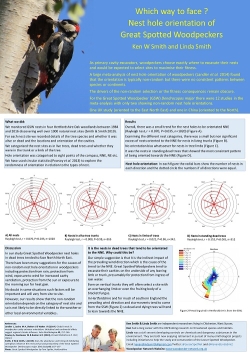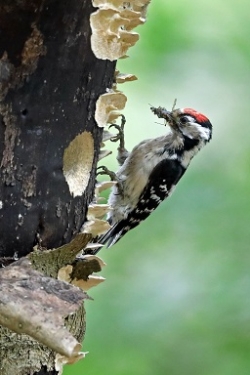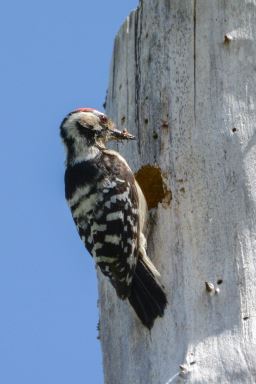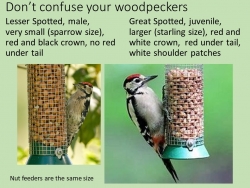Which way to face ? Nest hole orientation of Great Spotted Woodpeckers
Poster presentation by Ken Smith and Linda Smith for the Hole-nesting Birds Conference held in Oxford from 7-9 September 2022
As primary cavity excavators, woodpeckers choose exactly where to excavate their nests and would be expected to select sites to maximise their fitness.
We monitored GSW nests in four Hertfordshire Oak woodlands between 1984 and 2016 discovering well over 1000 natural nest sites (Smith & Smith 2019).
For each nest site we recorded details of the tree species and whether it was alive or dead and the locations and orientation of the cavities.
We categorised the nest sites as in live trees, dead trees and whether they were in the trunk or a limb of the tree.
Hole orientation was categorised to eight points of the compass, NNE, NE etc.
We have used circular statistics (Pewsey et al. 2013) to explore the randomness of orientation in relation to the types of nest.
Results
Overall, there was a small trend for the nest holes to be orientated NNE (Figure A).
Examining the different nest categories, there was a small but non significant excess of nests oriented to the NNE for nests in living trunks (Figure B).
No orientation bias whatsoever for nests in tree limbs (Figure C).
It was the nests in standing dead trees that showed the most consistent pattern of being oriented towards the North North East (Figure D).
Nest hole orientation: In each figure the radial bars show the number of nests in each direction and the dotted circle the numbers if all directions were equal.
Discussion
In our study Great Spotted Woodpecker nest holes in dead trees tended to face North North East.
There have been many suggestions for the causes of non-random nest hole orientation in woodpeckers including protection from rain, protection from wind, exposure to wind for increased cavity ventilation, protection from the sun or exposure to the morning sun for heat gain.
No doubt in some situations such factors will be important and will vary from site to site.
However, our results show that the non-random orientation depends on the category of nest site and so is not likely to be directly linked to the weather or other local environmental variables.
It is the nests in dead trees that tend to be orientated to the NNE. Why could this be?
Our simple suggestion is that it is the indirect impact of the prevailing wind direction which is the cause of the trend to the NNE. Great Spotted Woodpeckers tend to excavate their cavities on the underside of any leaning limb or trunk, presumably for protection from ingress of rain water.
Even on vertical trunks they will often select a site with an overhanging limb or even the fruiting body of a bracket fungus.
In Hertfordshire and for much of southern England the prevailing wind direction and storm events tend to come from the SSW (Figure 2) so dead and dying trees will tend to lean towards the NNE.
If you would like a copy of the poster please email us via the website
